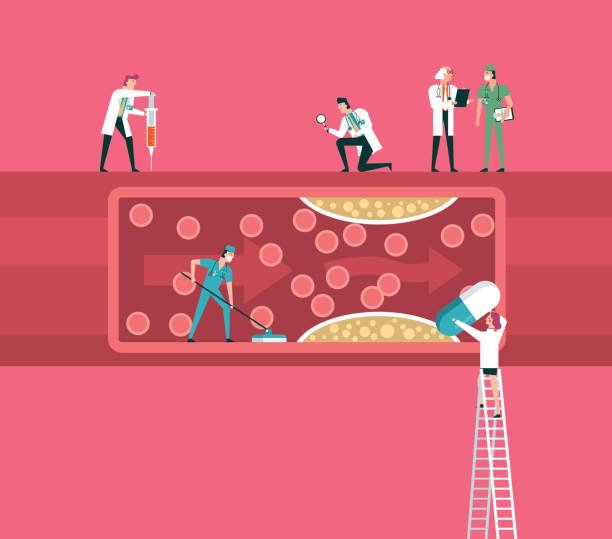
What is Atherosclerosis? Analysis of Causes, Symptoms, Diagnosis and Treatment of Arteriosclerosis
When the weather changes, cases of coronary heart disease, vascular obstruction or myocardial infarction are reported frequently, and proper terms such as “atherosclerosis” and “coronary atherosclerosis” also appear; after all, atherosclerosis What is sclerosis? Why do arteries harden? This article teaches you about the causes, risks, and complications of atherosclerosis.
What is atherosclerosis?
The word atherosclerosis (also known as atherosclerosis) originates from Greek. The prefix Athero means porridge, and sclesrosis means hardening. It specifically refers to the hardening of blood vessels due to fat accumulation. It is an arterial disease. A hardened one.
Why is there fat accumulation in blood vessels?
Broadly speaking, fat accumulation in blood vessels is caused by damage to the endothelial cells of blood vessels, triggering a reaction.
Simply put, damaged endothelial cells secrete an adhesive glycoprotein on the cell surface and increase vascular permeability, allowing low-density lipoprotein (LDL) to accumulate on the vascular endothelium (intima). ) undergoes oxidation, causing an inflammatory reaction in blood vessels, attracting monocytes to transform into macrophages, engulfing these oxidized lipoprotein particles, and finally forming foam cells. (Recommended reading: There is no worst, only worse! Cholesterol becomes bad, and lipoproteins are responsible!)
Dead foam cells, coupled with the proliferation and repair of connective tissue, will accumulate in the endothelium and middle layer of blood vessels, gradually forming fatty plaques. When fatty plaques continue to accumulate, the diameter of the arteries will become narrower and narrower. If the patient is deficient for a long time, During exercise, the muscle layer becomes rigid and inelastic. Over time, blood vessels are prone to hardening, narrowing due to plaque accumulation, and even vascular obstruction. If the relevant risk factors do not improve, the marks will accumulate into plaques, further affecting blood vessel health.

What happens with atherosclerosis?
Atherosclerosis is a chronic condition in which fatty plaque gradually accumulates on the inner walls of blood vessels, causing the inner diameter of the blood vessels to become increasingly narrow. Not only that, the fatty plaque on the inner wall of the blood vessel may also peel off, attracting platelets to attach to the endothelial injury, forming a blood clot and completely blocking the artery diameter.
If this happens in the coronary arteries of the heart, it can cause myocardial infarction; in the cerebral blood vessels, it can cause stroke. Even blood clots elsewhere in the body may peel off (like fatty plaques) and allow the blood clots to circulate with the blood flow, eventually getting stuck in smaller blood vessels, causing vascular embolism.
There are 2 types of arteriosclerotic fatty plaques
In addition, fatty plaques are also subdivided into stable and unstable plaques; unstable plaques are more likely to rupture and are also the main cause of myocardial infarction and acute coronary heart disease.
Stable plaques can be called “calcifications.” This type of plaque is not easy to rupture, so acute symptoms are less likely to occur, but there are still problems with arteriosclerosis and stenosis. For example, aortic valve stenosis, which is common in the elderly, is closely related to the formation of stable plaque in the valve and calcification.
Symptoms of atherosclerosis: If you feel unwell, seize the golden 3 hours to seek medical attention
Because the accumulation of fatty plaques accumulates over time, patients with mild atherosclerosis usually do not have any symptoms until the artery diameter has been compressed to a small size by the plaque, or the plaque ruptures and causes a thrombus to block the artery. Obvious discomfort occurs. Depending on the location of the atherosclerosis, patients will have different symptoms. Here are three types:
- Coronary atherosclerosis: Patients experience chest pain (angina pectoris) or a feeling of being out of breath or feeling like a heavy object is pressing on their chest.
- Cerebrovascular: Patients may experience symptoms such as limb paralysis, difficulty speaking, confused speech, temporary blindness in one eye, or drooping of unilateral facial muscles, as well as transient ischemic attack. If the symptoms continue to worsen, they may evolve. for stroke.
- Atherosclerosis that occurs in the legs or hands is called peripheral artery disease. Most symptoms occur in the patient’s lower limbs, and there may be intermittent claudication and lower limb ischemia.
When should you seek medical help?
Since atherosclerotic plaques and stenosis are recognized vascular risk factors for stroke, if you or your relatives or friends have symptoms suspected of atherosclerosis (chest pain, numbness in your feet, etc.), please seize the golden treatment period as soon as possible and should do so within 3 days Seek medical diagnosis within hours to avoid delays and irreversible regrets.

11 risk factors for atherosclerosis
Now we know that damage to the vascular endothelium is the cause of fat mass accumulation. And who is the culprit that causes endothelial damage and fat accumulation on the inner walls of blood vessels? The 11 most common risk factors currently known are as follows:
- Hypertension
- Senescence
- High triglycerides
- Family history of premature heart disease
- Smoking
- Excessive drinking
- Obesity
- Diabetes
- Inflammations such as arthritis, systemic lupus erythematosus (SLE), or other infections.
- Lack of exercise
- Unhealthy diet
Six major complications of atherosclerosis: Old and inelastic blood vessels come to your doorstep
- Coronary heart disease
- Peripheral arterial disease
- Aneurysms
- Chronic kidney disease
- Carotid artery disease
- Stroke
Six diagnostic methods for atherosclerosis
Generally speaking, depending on the type of atherosclerosis, in order to understand the exact location and shape of atherosclerosis, doctors usually use cardiac catheterization and combine the following other diagnostic methods to determine:
- Blood test:
Check whether there are any abnormalities in blood sugar and blood lipid values, which may be signs of atherosclerosis. - Auscultation:
Determine the status of atherosclerosis with a stethoscope, and determine diagnosis and treatment by listening to the murmur of blood flow. - Cardiac Catheterization:
Mainly used to examine the coronary arteries. A catheter is inserted through the inguinofemoral artery and a contrast agent is injected to understand the condition of the artery through images. - Computed tomography scan (CT scan):
Detects arterial calcification to help determine the condition. - Echocardiography:
Superficial arterial plaques can be found using this method. - Ankle Brachial Pressure Index:
Abbreviated as ABI, it determines whether the subject has peripheral arterial disease by comparing blood pressure in the calf and upper arm.
Other methods include:
- Electrocardiography
- Exercise electrocardiogram
- X-ray
- Nuclear medicine examination
Is atherosclerosis reversible? Treatment method
Doctors will choose appropriate drugs and treatments based on the patient’s atherosclerosis status and complications. If the atherosclerosis is more severe, surgery will need to be considered.
Medical treatement
- Cholesterol-lowering drugs:
drugs such as statins, which can reduce the concentration of LDL in the blood. - Blood pressure lowering drugs:
such as β-blockers, Angiotensin-converting enzyme inhibitors (ACEI), Calcium channel blockers (CCB), diuretics ). - Antiplatelet drugs:
such as aspirin, which prevent platelets from aggregating and preventing blood clots from forming. - Thrombolytic therapy:
Inject drugs into a vein to dissolve blood clots.
Surgical treatment
- Angioplasty:
Angioplasty is also called cardiac catheterization, balloon dilation, etc. Similar to cardiac catheterization, a catheter is inserted into a blood vessel and guided to the atherosclerotic area. The balloon carried by the catheter is inflated to open the narrow blood vessel wall. Depending on the patient’s condition, a stent may be considered to prevent the dilated blood vessel from narrowing again. - Carotid endarterectomy:
Surgery to remove fatty plaque from the carotid arteries. The doctor will clamp the upper and lower ends of the carotid arteries and then incise the carotid arteries to remove the plaque in the intima. - Coronary Artery Bypass Graft (CABG):
When the patient’s heart’s coronary arteries are too severely blocked, this surgery may be used to transplant blood vessels from other parts of the patient’s heart to the heart as an alternative channel for the blocked coronary arteries.
5 rules to prevent atherosclerosis
Atherosclerosis is a chronic disease. However, once the risk factors are triggered, the risk of sudden death or acute cardiovascular disease is extremely high. Therefore, it is recommended that diet and bad living habits should be improved immediately to prevent the occurrence of cardiovascular disease! Here are 5 life rules to prevent and improve atherosclerosis:
- Healthy diet:
Reduce the intake of saturated fats such as red meat, butter, pastries and sweets, which will increase the concentration of LDL in the body. - Regular exercise:
Exercise helps burn calories, avoid obesity and maintain blood vessel elasticity. - Quit smoking:
Nicotine damages the endothelium of blood vessels. - Avoid excessive alcohol consumption:
Consuming large amounts of alcohol may cause damage to the heart muscle and may also lead to obesity due to excessive caloric intake. - Regular health check-ups:
Regularly tracking your own blood lipids, blood sugar, and blood pressure can help you understand risk factors and prevent them early.












